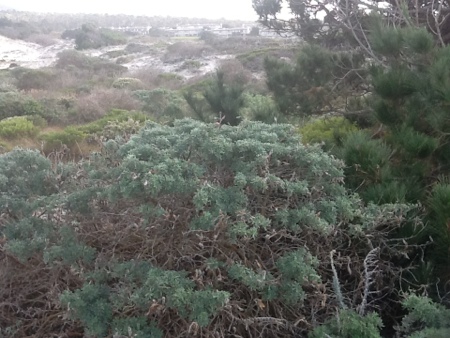Breeders and genomics researchers are meeting at the Asilomar Conference Grounds, Pacific Grove, California to discuss how genomics can facilitate the use of crop wild in crop improvement. Follow on Twitter using #cwrgenomics. The wild lupin in the photo is found on the sand dunes just outside the conference facilities. There’s also a smaller, rarer one, but I haven’t found it yet.
Brainfood: Core collections, Romanian pigs, Commons, Valuation, Biofortification, Yam characterization, Pompeii diet, Rice grain genetics
- Maximizing genetic differentiation in core collections by PCA-based clustering of molecular marker data. It works. In simulations, to be fair.
- Study of rare traditional pork breeds concerning the aspect of biodiversity conservation. Mangalitsa is what you want, apparently.
- Open Variety Rights: Rethinking the Commodification of Plants. A “protected commons”? Sounds a bit like the ITPGRFA to me.
- Natural and cultural heritage in mountain landscapes: towards an integrated valuation. Yeah, but does your cultural heritage include things like agricultural biodiversity?
- Fortifying plants with the essential amino acids lysine and methionine to improve nutritional quality. Conventional breeding hasn’t worked. But has it been for want of trying? Just askin’.
- Genetic and phenotypic diversity in a germplasm working collection of cultivated tropical yams (Dioscorea spp.). Relationships among species, synonyms, duplicates, yada yada.
- Roman food refuse: urban archaeobotany in Pompeii, Regio VI, Insula 1. Romans ate a Mediterranean diet. Still no cure for cancer.
- Genetic bases of rice grain shape: so many genes, so little known. Why bother? Just askin’.
Nibbles: Survival seeds, Turkish agrobiodiversity, Mainstreaming nutrition, Hot times for conservation, Ethiopian sesame, Conserved DNA
- Survival seed bank in the news again. Must be Christmas.
- Turkish nibbles: wine, pictachios. That wine one will no doubt run and run.
- How to make sure nutrition gets a seat at the agricultural development table. And Danny breaks it down for ya.
- What leads to spurts in conservation effort? In situ only, but instructive.
- Sesame is big business in Ethiopia.
- Boffins find yet another bit of DNA that will save the world.
Chicken salad
Ultimately, researchers hope to get ancient DNA from well-dated bones. But “replicable DNA has been as rare as hen’s teeth,” Zeder says, thanks to contamination issues and tropical climes that degrade DNA. One team recently claimed to have mtDNA from an ancient Polynesian chicken bone in Chile — a dramatic find that would prove Polynesians reached the Americas before Columbus — but the find has been questioned as possibly contaminated (Science, 11 June 2010, p. 1344). Techniques are improving, however…
That cliff-hanger is a quote from a rather attractive Science spread enticingly entitled “In Search of the Wild Chicken,” reproduced a few days ago in an ILRI blog post. It’s a great story, but one wonders why there was not at least a mention of the recent paper in PLOSOne “Investigating the Global Dispersal of Chickens in Prehistory Using Ancient Mitochondrial DNA Signatures.” Those authors, after all, had 92 — count them!! — archaeological chicken bones to play with, and spun a convincing tale of “multiple prehistoric dispersals from a single Asian centre” from their analysis. Is there something of a rivalry developing in the highly competitive world of chicken DNA? Probably not, and no doubt we’ll be getting lots of cease and desist notices from the denizens of said world for even suggesting such a thing.
Nibbles: School genetics, Sigrid Heuer, Fungal sex, Rubber, Wine, James Scott, Sustainable diets meet, Food exhibit, EU and climate change
- Much may be made of a wheat gene-jockey, if he be caught young.
- Or rice gene-jockeys, for that matter.
- Lots of naughtiness going on in blue cheese.
- Hope those reprobate fungi are using sustainable Amazonian rubbers.
- Some wine with that naughty cheese?
- Learning Burmese, researching the deep history of crops. Meah.
- Start planning for the next sustainable diets symposium. Symposium is quite apt, isn’t it.
- Feast your eyes on Feast Your Eyes.
- European agriculture is totally prepared for this climate change whatsit.
